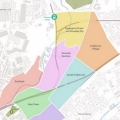 I have just finished reading an autobiography of Jane Jacobs, one of the most well-known writers about urban planning and a lifelong community activist. Her most famous book is the The Death and Life of Great American Cities. Coincidentally, at the end of last week, I received an invitation, along with everyone else in Manchester, to consult on the Northern Gateway, a massive proposed redevelopment of parts of North Manchester close to Manchester City Centre.
I have just finished reading an autobiography of Jane Jacobs, one of the most well-known writers about urban planning and a lifelong community activist. Her most famous book is the The Death and Life of Great American Cities. Coincidentally, at the end of last week, I received an invitation, along with everyone else in Manchester, to consult on the Northern Gateway, a massive proposed redevelopment of parts of North Manchester close to Manchester City Centre.
Jane Jacobs wrote her book when she was living in Greenwich Village in New York in the early 60s. It was a time when large American Cities were creating grand plans to build transit systems and redevelop slums. In New York this was headed up by Robert Moses, a city official who wielded huge influence. This was (and still is) the era of the car and Moses proposed to build a series of freeways that linked the expanding suburbs to the centre of New York. These would destroy or cut in half many communities that were considered to be slums, including where Jacobs lived. These places were considered slums because the housing was old, high density and often with narrow streets and vacant lots. Moses saw no value in these areas of the city and wanted to build new office blocks and shops and transfer residents elsewhere (some of this alternative accommodation became infamously known as “the Projects”).
In her book, Jacobs, described the life and energy of her neighbourhood, the ecosystem that made it a diverse, economically active, and vibrant place. She spoke about the sidewalk and its importance as a place where children played and where neighbours met. She described how new ventures arose from the intermingling of local business and residents, how this was the economic life blood of cities. She described complexity and interdependence and the importance of this to the quality of life in a city. She railed against rationalist Urban Planning that was about grand theories, focused on buildings and infrastructure rather than people and communities. She advocated refurbishment rather than demolition, in-filling (adding more housing on vacant lots), and advocated against road widening or reductions in pavement size and saw the car as the enemy of community. She emphasised the importance of cheap and run-down buildings as part of the mix, as this is where new businesses could get a foothold. She was all about understanding the human-size. She organised and worked with people from her neighbourhood and stood up against Moses and the rich developers and won. The motorway never got built and Greenwich Village, where she lived, remained and was key to the artistic regeneration of New York. Her vision and insights have informed urban planning theory since.
Manchester, also had a grand city plan written in 1945, at a time when the war was coming to an end and planners (and the country) were feeling renewed hope about the future. The plan was put together by the City Surveyor and envisaged knocking down large parts of the city centre, replacing the old, with the new and creating a magnificent processional way that would lead from the town hall to the courts (never built). Most of the plan didn’t happen but it did lead to the building of the pre-bomb Arndale, a grim, concrete maze. Similar to the Moses plan in New York a series of arterial roads were planned leading from the suburbs into the city centre. Only one was fully built, Princess Parkway, however either sides of Rochdale Road and Oldham Road were cleared in preparation creating a blight along the sides of the road, populated by the occasional pub or church which were spared. As with all plans the 1945 Manchester City Plan was full of noble values and worthwhile ideas. It is 270 pages long, much the same length as the consultation for the Northern Gateway. One of the proposals in the Northern Gateway is to repair some of the damage done to Rochdale Rd.